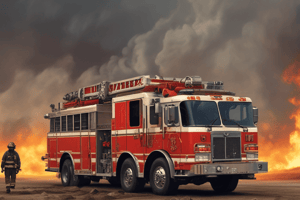Podcast
Questions and Answers
What is the primary objective of the guidelines for firefighting operations in high-rise buildings?
What is the primary objective of the guidelines for firefighting operations in high-rise buildings?
- To ensure all Toronto Fire Services personnel understand their roles
- To provide all Toronto Fire Services personnel with a guideline for firefighting operations (correct)
- To develop an Incident Action Plan (IAP) for high-rise emergencies
- To provide a detailed plan for evacuating civilians
Who is responsible for ensuring personnel follow TFS SOGs during high-rise firefighting operations?
Who is responsible for ensuring personnel follow TFS SOGs during high-rise firefighting operations?
- All personnel (correct)
- Sector Officers
- Incident Commanders
- Toronto Fire Services Administration
What is the first step in the size-up process for high-rise buildings?
What is the first step in the size-up process for high-rise buildings?
- Direct incoming apparatus to alternate locations
- Communicate an initial radio report (correct)
- Establish a perimeter or safe zone around the building
- Upgrade the incident to a second alarm
What is the primary concern during high-rise firefighting operations?
What is the primary concern during high-rise firefighting operations?
What should incoming apparatus do during a high-rise emergency response?
What should incoming apparatus do during a high-rise emergency response?
What may be included in the initial size-up report?
What may be included in the initial size-up report?
What is the responsibility of Sector Officers during high-rise firefighting operations?
What is the responsibility of Sector Officers during high-rise firefighting operations?
Why may incoming apparatus be directed to alternate locations?
Why may incoming apparatus be directed to alternate locations?
What is the initial approach location in most cases?
What is the initial approach location in most cases?
What is the primary task of the driver of the apparatus?
What is the primary task of the driver of the apparatus?
What is the purpose of obtaining keys and building information?
What is the purpose of obtaining keys and building information?
When should an EVAC announcement be made?
When should an EVAC announcement be made?
What is the minimum equipment required for the initial crew?
What is the minimum equipment required for the initial crew?
What should be done if smoke or fire is encountered during investigation?
What should be done if smoke or fire is encountered during investigation?
What is the procedure to follow when transferring command?
What is the procedure to follow when transferring command?
What is the purpose of proceeding to two floors below the alarm location?
What is the purpose of proceeding to two floors below the alarm location?
Flashcards are hidden until you start studying
Study Notes
High Rise Firefighting Operations
- The guideline is for all Toronto Fire Services personnel for firefighting operations in high-rise buildings.
Responsibility
- All personnel are responsible for understanding and following TFS SOGs during high-rise firefighting operations.
- Sector Officers are responsible for personnel assigned to their Sector during firefighting operations in any high-rise emergency situation.
- Incident Commanders are responsible for developing an Incident Action Plan (IAP) including Strategy, Tactics, and Implementation of IMS.
Tactical Priorities
- Rescue and Life Safety
- Incident Control
- Exposure Protection
- Property Conservation
Guidelines for High Rise Firefighting
Size-Up
- A full size-up may not be possible in high-rise buildings due to complexity and size of the structure.
- Incoming apparatus with different vantage points shall aid in the initial size-up.
- Report any important information to the Incident Commander.
Initial Radio Report
- Communicate an initial radio report as per TN 106.13 - Size up to Toronto Fire, confirming the address, building type, occupancy type, any visible signs, the assumption and designation of command, and PAR status.
First Arriving Apparatus
Initial Approach
- Made to a pre-planned point of entry unless dispatched to an alternate point.
- Initial approach location shall be to the main entrance (Alpha side) having the annunciator panel, security/superintendent personnel, and Emergency Voice Alarm Communication (EVAC) system.
Initial Tasks
- Confirm the location and type of alarm indicated on annunciator panel.
- Obtain information from responsible building personnel and occupants, if possible.
- Obtain keys and building information (floor plans) from the Fire Safety Plan box for elevators, mechanical rooms, and residences, if possible.
- An EVAC announcement may be made if the emergency incident dictates.
- Report alarm location, any pertinent information, and your actions to Toronto Fire.
Minimum Equipment for Initial Crew
- One donned SCBA per fire fighter with face piece.
- One portable radio per fire fighter.
- One portable hand light per fire fighter.
- One set of irons (flathead axe, 30" Halligan).
- 3 x 15 metre 65mm Hose Packs and Standpipe Kit.
- Thermal Imaging Camera.
Studying That Suits You
Use AI to generate personalized quizzes and flashcards to suit your learning preferences.



